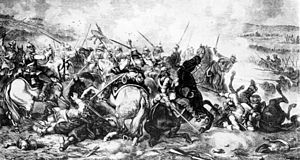Battle of Gravelotte
| Battle of Gravelotte | |||||||
|---|---|---|---|---|---|---|---|
| Part of the Franco-Prussian War | |||||||
 Massacre of Prussian Cuirassiers at Gravelotte. Drawing by Juliusz Kossak, 1871 |
|||||||
|
|||||||
| Belligerents | |||||||
|
|
|
||||||
| Commanders and leaders | |||||||
| Helmuth von Moltke | François Achille Bazaine | ||||||
| Strength | |||||||
| 188,332 732 guns |
112,800 520 guns |
||||||
| Casualties and losses | |||||||
| 5,237 killed 14,430 wounded 493 captured or missing |
1,146 killed 6,709 wounded 4,420 captured or missing |
||||||
The Battle of Gravelotte (or Gravelotte–St. Privat) on 18 August 1870 was the largest battle during the Franco-Prussian War, named after Gravelotte, a village in Lorraine between Metz and the former French–German frontier. It was fought about 6 miles (9.7 km) west of Metz, where on the previous day, having intercepted the French army's retreat to the west at the Battle of Mars-La-Tour, the Prussians were now closing in to complete the destruction of the French forces. The combined German forces, under Field Marshal Count Helmuth von Moltke, were the Prussian First and Second Armies of the North German Confederation numbering about 210 infantry battalions, 133 cavalry squadrons, and 732 heavy cannons totaling 188,332 officers and men. The French Army of the Rhine, commanded by Marshal François-Achille Bazaine, dug in along high ground with their southern left flank at the town of Rozerieulles, and their northern right flank at St. Privat.
The battlefield extended from the woods that border the Moselle above Metz to Roncourt, near the river Orne. Other villages which played an important part in the battle of Gravelotte were Saint Privat, Amanweiler or Amanvillers and Sainte-Marie-aux-Chênes, all lying to the north of Gravelotte. The combined German forces, under Field Marshal von Moltke, were the Prussian First and Second Armies of the North German Confederation. The French Army of the Rhine, commanded by Marshal Bazaine, dug in along high ground with their southern left flank at the town of Rozerieulles, and their northern right flank at St. Privat.
On 18 August, the battle began when at 08:00 Moltke ordered the First and Second Armies to advance against the French positions. By 12:00, General Manstein opened up the battle before the village of Amanvillers with artillery from the Hessian 25th Infantry Division. But the French had spent the night and early morning digging trenches and rifle pits while placing their artillery and their mitrailleuses in concealed positions. Finally aware of the Prussian advance, the French opened up a massive return fire against the mass of advancing Germans. The battle at first appeared to favor the French with their superior Chassepot rifle. However, the Prussian artillery was superior with the all-steel Krupp breech-loading gun. By 14:30, General Steinmetz, the commander of the First Army, unilaterally launched his VIII Corps across the Mance Ravine in which the Prussian infantry were soon pinned down by murderous rifle and mitrailleuse fire from the French positions. At 15:00, the massed guns of the VII and VIII Corps opened fire to support the attack. But by 16:00, with the attack in danger of stalling, Steinmetz ordered the VII Corps forward, followed by the 1st Cavalry Division.
...
Wikipedia
